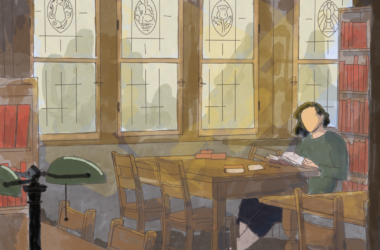 creations-gallery.com
creations-gallery.comWest Wind: the Vision of Tom Thomson by Michèle Hozer and Peter Raymont, isn’t a documentary so much as a detective story. Yes, there is a love triangle, and an unexplained death that may or may not be a murder, but these aren’t the mysteries Hozer and Raymont are interested in. Tom Thomson’s unsolved death often overshadows his life, and even his paintings. What West Wind focuses on, instead, is getting to know the compelling but elusive mind of the man himself, through his stunning body of work.
Tom Thomson spoke little and wrote even less. The film opens with one of his rare letters, which ends with the simple line, “I will stick to my painting as long as I can.” One thing is clear: Thomson needs to create. The film’s detective work sketches the rest of his character. Interviews with curators, art historians, passionate collectors, the words of Thomson’s family and friends, and charming grainy photos and film clips all help us get to know the famous Canadian artist.
This technique makes West Wind a film about a sickly boy who found his strength and his inspiration in nature. He’s a man who gave up a secure career in commercial art to follow his passion. A pacifist who fought against social pressure to keep doing what he loved. A painter who persisted despite savage critical reviews.
The most remarkable evidence we have about Thomson, however, lies immortalized in his paintings. West Wind presents the most recognizable works, balanced with quick sketches, oils hidden away in private collections, and downright obscure pieces. Together, they form a picture of a brilliant and endlessly inspired creative mind. There was no telling when his muse would make herself known-Tom was known to paint by lamplight in the darkest nights or fiercest storms. His paintings all centre on Northern Ontario, but their variety is astounding. As his friend and later Group of Seven member A.Y. Jackson put it, “Not knowing the conventional definitions of beauty, he found it all beautiful.”
This is the true legacy of Tom Thomson. He re-imagined Canada, forever altering its character-perceived before him as a cruel, monotonous landscape. After Tom, we have Canada the powerful, the wild, the beautiful.
In an act of either awful irony or poetic justice, this is the same Canada that claimed Thomson’s life. His waterlogged body and capsized canoe turned up on Canoe Lake, Algonquin Park, on July 8, 1917. Of course, Hozer and Raymont have to address this captivating story, but the film treats the intrigue like a fascinating final chapter, rather than the defining aspect of Thomson’s life. The evidence presented is less objective, hinting at murder, considering his odd head injury and false burial.
Tom Thomson’s death is still a mystery, and one that will likely never be solved. But the true allure of Thomson’s death is his life-a life that West Wind: the Vision of Tom Thomson‘s research and shaping makes all the more interesting.







